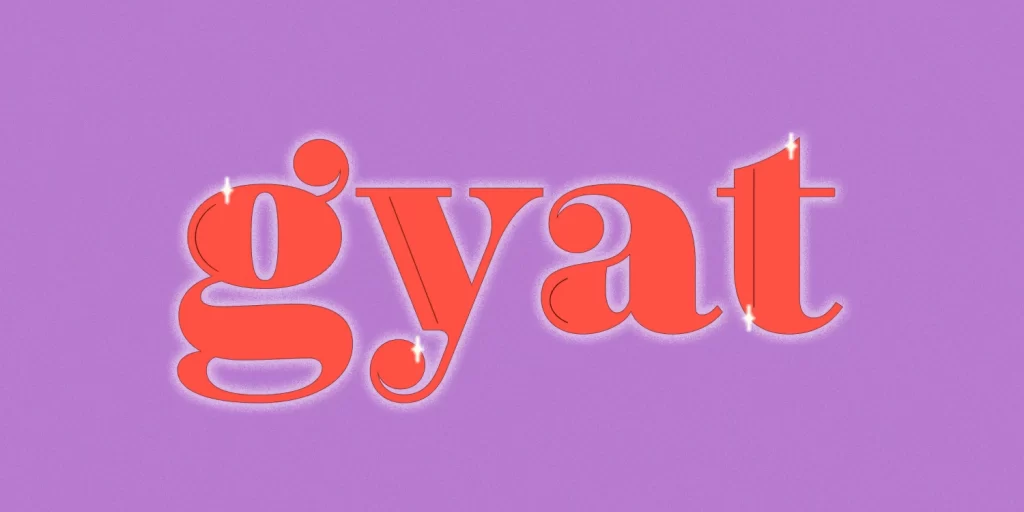Demystifying “Gyat”: A Multifaceted Slang Term with Evolving Meanings
The internet lexicon is a constantly evolving landscape, brimming with abbreviations, acronyms, and slang terms. “Gyat” is one such term that has recently gained traction, particularly on social media platforms like TikTok. But what exactly does “gyat” mean? This comprehensive guide delves into the origins, interpretations, and proper usage of “gyat,” exploring its multifaceted nature.
A Word with Roots: The Origins of “Gyat”
“Gyat” is derived from a misspelling or abbreviation of the word “goddamn.” This origin story aligns with similar slang terms like “dang” or “gosh darn,” euphemisms that emerged to avoid profanity. Early online usage of “gyat” can be traced back to the late 2000s, primarily employed as an exclamation in reaction to surprise or excitement.
A Semantic Shift: Gyat’s Modern Interpretation
However, in the 2020s, “gyat” experienced a significant semantic shift. It gained a secondary meaning, often associated with complimenting someone with a curvaceous figure, particularly a large butt. This usage is believed to have been popularized by online streamers and social media influencers, with frequent appearances in comments sections praising women with hourglass figures.
Understanding Context: When to Use (or Avoid) Gyat
The appropriate usage of “gyat” depends heavily on context. Here’s a breakdown of the two main interpretations:
-
Exclamation of Surprise or Excitement: In this context, “gyat” functions similarly to “wow,” “damn,” or “oh my gosh.” It can be used casually between friends or online communities to express strong emotions like surprise, excitement, or amusement. For example, you might comment “gyatttt” on a friend’s social media post showcasing an impressive achievement.
-
Complimenting Physical Appearance: This interpretation of “gyat” is primarily used to compliment someone with a curvy body or large buttocks. It’s important to exercise caution with this usage, particularly in unfamiliar settings. While intended as a compliment, some might perceive it as objectifying or disrespectful. Consider the context and your relationship with the person before using “gyat” in this way. A safer alternative might be a more general compliment like “you look great!”
Frequently Asked Questions (FAQ)
Q: Where did “gyat” originate?
A: “Gyat” is derived from a misspelling or abbreviation of “goddamn,” used as a mild exclamation in the late 2000s.
Q: What does “gyat” mean?
A: “Gyat” has two main interpretations:
- Exclamation: Expressing surprise, excitement, or amusement (similar to “wow” or “damn”).
- Compliment: Praising someone with a curvaceous figure, particularly a large butt (use with caution).
Q: Is it okay to use “gyat”?
A: The appropriateness of using “gyat” depends on the context. As an exclamation, it’s generally casual and acceptable between friends. When used as a compliment, proceed with caution and consider alternative phrasing.
Q: How do I pronounce “gyat”?
A: “Gyat” typically rhymes with “squat” or “bought.”
Q: Are there other slang terms similar to “gyat”?
A: Yes, the internet is full of evolving slang terms. Some similar terms in meaning or origin include “bae” (significant other), “fleek” (on point, stylish), and “lit” (excellent, exciting).
Understanding Slang: The Ever-Evolving Language of the Web
The internet has become a breeding ground for new words and phrases, with slang terms constantly emerging and evolving. While this vibrancy keeps online communication fresh and engaging, it can also be challenging to keep up with the latest lingo. This section explores the reasons behind the rise of internet slang, the challenges it presents, and some tips for navigating this ever-changing linguistic landscape.
Why Does Slang Thrive Online?
Several factors contribute to the proliferation of slang on the internet:
- Shorthand Communication: Slang often functions as a shorthand, allowing for faster and more concise online communication, particularly on platforms with character limitations (e.g., Twitter). Abbreviations like “LOL” (laugh out loud) or “BRB” (be right back) save time and typing effort.
- Building Community: Slang can foster a sense of belonging within online communities. Shared use of specific terms creates a sense of in-group identity and can act as a social marker. For example, gamers might develop their own slang terms specific to their favorite games.
- Humor and Creativity: Slang is often playful and humorous, adding a lighthearted touch to online interactions. The constant invention of new slang terms reflects the creativity and dynamism of online communities.
The Challenges of Slang: When Does it Become a Barrier?
While slang has its advantages, it can also present challenges:
- Generational Divide: Slang terms can quickly become outdated, creating a communication gap between generations. What’s trendy for teenagers might be completely baffling to adults.
- Misunderstandings: The informal and ever-evolving nature of slang can lead to misunderstandings, especially across cultures or online communities with different norms. A term meant as a compliment in one group might be seen as offensive in another.
- Exclusion: The rapid evolution of slang can leave some people feeling excluded, particularly those not actively involved in online communities where new terms originate.
Keeping Up with the Lingo: Tips for Navigating Slang
Here are some tips for staying informed about slang and navigating online communication effectively:
- Immerse Yourself: Spend time in online communities relevant to your interests, but be mindful of potentially offensive or harmful slang.
- Ask Questions: Don’t be afraid to ask friends or family what a particular slang term means if you’re unsure.
- Stay Curious: Embrace the ever-changing nature of language and see slang as a fascinating reflection of online culture.
- Context is Key: Pay attention to the context in which slang is used to understand its intended meaning.
In Conclusion
“Gyat” is a multifaceted slang term with a unique online evolution. By understanding its origins, interpretations, and appropriate usage, you can navigate the ever-changing landscape of internet slang with confidence. Remember, context is key! When unsure, a more traditional compliment might be the safer route.



